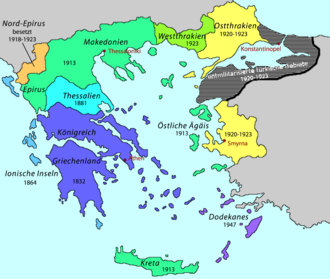Megali Idea


The Megali Idea ( Greek Μεγάλη Ιδέα Megáli̱ Idéa ), the great idea , describes the motto of Greek nationalism until around 1922. The background was that Greece only gained independence with a fraction of the Greek-populated territory and only later grew into its present territory. At the latest with the claim to annex the Greek-settled coast of Asia Minor to Greece, the Megali Idea also met with resistance in Greece. The brief capture of parts of the coast of Asia Minor in 1920 with the city of Smyrna was followed by the " Asia Minor Catastrophe " and the killing or expulsion of the Greeks living there.

(the international zone created in the Treaty of Sèvres , which had to be demilitarized by Turkey and which was claimed by Greece as future national territory until 1923, is hatched in gray )
history
Even the Greek revolutionaries after 1821, who longed for the Byzantine Empire and tried to found a large Hellenic empire with the capital Constantinople , adhered to this idea. The first to propagate the Megali Idea was the writer and revolutionary Rigas Velestinlis . After the start of the War of Liberation in 1821, all that remained of his plan for a multi-ethnic republic was the desire to unite all Greeks in one nation state. He drew the first map of the Megali Idea in Bucharest in 1791 , had it printed in 1796 and then distributed it first in Vienna and later in the Greek-speaking areas of the Ottoman Empire . On this map, most of the countries of the Balkan Peninsula , Crete , Rhodes , Thessaloniki , Cyprus , the Aegean Islands , Thrace and Constantinople were marked as “areas to be liberated”.
In those days a movement arose which - far removed from the intentions of most of the Greeks of the time and also devoid of any prospect of success - had made it its goal to realize the Megali Idea . Notwithstanding this, the Greek government managed to expand its national territory step by step. The glorification of the Byzantine Empire had become an indissoluble unity with the claim to the historical areas of Greece.
The most important supporter of the "big idea" was the Greek politician Eleftherios Venizelos , who as Prime Minister in the Balkan Wars from 1912 to 1913 was able to expand the Greek territory (from 64,657 km² to 121,268 km²). At that time the southern part of Epirus , Crete and the southern part of Macedonia were annexed to the Greek state. Thessaly had already been annexed in 1881.
With a consensus of the “national cause” in foreign policy, proponents also hoped that the fissured party-political situation at home would move closer together. After the victory of the Entente in World War I and the Treaty of Sèvres , the realization of the “great idea” seemed to have come a great deal closer: the northern part of Epirus, the islands of Imbros and Tenedos and Thrace (but not Constantinople) were assigned to Greece .
Sir Basil Zaharoff donated half a billion gold francs to the Greek state in 1920 for the realization of the Megali Idea, but also supported the Ottoman Empire with arms deliveries.
The defeat of Greece in the Greco-Turkish War (1919–1922) was a major setback for the supporters of the nationalist idea and finally crushed them. The Lausanne Treaty stipulated that Imbros and Tenedos should belong to Turkey in the future. Greece also lost Northern Epirus to Albania , the area around Smyrna (today Izmir) in Asia Minor and Eastern Thrace to Turkey.
In the course of the "population exchange" of Greeks and Turks at that time, the forcible expulsion of the respective national minorities due to the convention on population exchange between Greece and Turkey , the Greek population , which had been at home in Asia Minor for almost three millennia, disappeared almost completely from that region.
See also
literature
- Ioannis Zelepos : The Ethnicization of Greek Identity 1870–1912. State and private actors against the background of the "Megali idea" (= Southeast European works. Volume 113). R. Oldenbourg, Munich 2002, ISBN 3-486-56666-0 (also: Berlin, Free University, dissertation, 2000).
Web links
Individual evidence
- ↑ Zelepos: The Ethnicization of Greek Identity 1870–1912. 2002, p. 8.
- ↑ a b Edgar Hösch (ed.): Lexicon for the history of Southeast Europe (= UTB 8270). Böhlau, Vienna a. a. 2004, ISBN 3-205-77193-1 , p. 434 f.
- ^ Hans Hallmann: New Greece History. 1820-1948. H. Bouvier and Co., Bonn 1949, p. 132.
